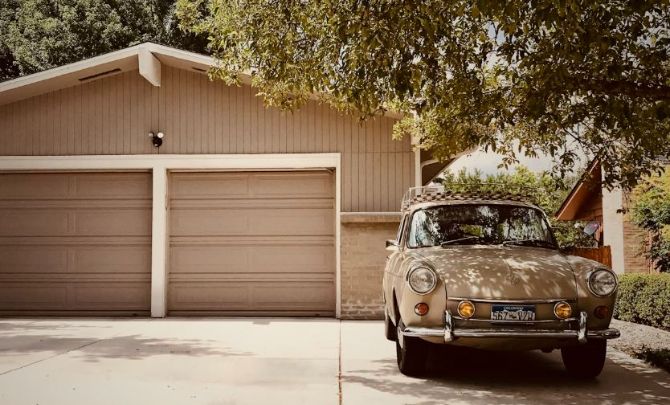Your garage door system is one of your home’s most heavily used mechanical components. It moves up and down multiple times daily, often without much thought, until something goes wrong. A tune-up and inspection can help prevent unexpected breakdowns and costly repairs by identifying potential problems early. This routine service not only ensures the safety of your household but also extends the life of the door, opener, and other hardware.
Knowing what happens during a full garage door inspection can help you understand the value of regular maintenance and stay ahead of mechanical wear.
A step-by-step look at the inspection process
- Visual and Operational Inspection
The inspection begins with a visual and operational overview. The technician checks for any immediate signs of damage or unusual movement while opening and closing the door. They watch for misalignment, warping, rust, or wear on panels and tracks. By observing how the door behaves during a few cycles, they can detect early signs of stress, lag, or imbalance. This step sets the foundation for a deeper inspection by flagging areas that require closer attention. Many homeowners reach out for a Coquitlam garage door repair after noticing these subtle performance changes, unaware that they could have been addressed earlier with a simple tune-up. Identifying these small indicators can prevent breakdowns and preserve the smooth operation of the entire system. During this stage, technicians also take note of sounds such as grinding, squeaking, or rattling, all of which could point to loose components or insufficient lubrication.
- Checking Springs and Balance
Torsion and extension springs bear most weight when a garage door operates. These high-tension components are critical for smooth, safe movement. A technician checks whether the springs are correctly tensioned, looking for gaps, rust, or signs of overstretching. Balance is tested manually by disengaging the opener and lifting the door halfway. A properly balanced door will stay in place without drifting up or down. If it moves, the springs may be failing or uneven. These adjustments require precision, as incorrect tension can place stress on the opener and cause motor strain. Maintaining spring health is crucial not only for operation but for safety. A broken spring can snap violently, creating a risk for injury or property damage. The technician will also inspect mounting brackets and cables associated with the springs to ensure they’re intact and secure.
- Inspection of Rollers, Hinges, and Tracks
Smooth operation depends on how well the door glides along its tracks. Rollers must be clean, undamaged, and well-lubricated to function correctly. Steel rollers may show signs of rust, while nylon rollers often reveal cracks or flattened edges over time. During the tune-up, each roller is checked and cleaned. Hinges connecting the panels are examined for loose screws, misalignment, or wear, especially near the bottom where stress is most significant. If hinges are too loose or rusted, they can cause panels to separate during movement. The tracks themselves are inspected for debris, dents, or warping. A track that’s even slightly bent can throw off the entire door’s movement, causing rollers to slip or become jammed. Adjustments to the track alignment are made as needed, ensuring that the door moves freely and evenly with minimal resistance. Cleaning the tracks and applying proper lubrication helps prevent future sticking or skipping.
- Garage Door Opener and Safety Feature Testing
After mechanical components are examined, attention shifts to the garage door opener. The technician evaluates the condition of the drive mechanism—whether chain, belt, or screw-driven—and listens for signs of stress, like chattering or motor hesitation. The opener’s settings are also checked to ensure the door opens and closes fully without excessive force. One of the most critical aspects of this phase is testing the auto-reverse safety function. This involves placing a small object in the door’s path and ensuring it reverses direction when it makes contact. The technician verifies that the photo-eye sensors are clean, aligned, and functioning correctly. Any lag or failure in these safety systems is addressed immediately, as they are essential to preventing injury or damage. Remote controls and wall-mounted buttons are also tested for responsiveness and battery life. Adjustments to the opener’s settings may be made to fine-tune the closing speed and force sensitivity.
- Lubrication and Final Adjustments
Once the system is inspected and any issues are addressed, the tune-up concludes with lubrication of key components. This includes applying appropriate grease or spray lubricant to rollers, hinges, springs, and bearing plates. Lubrication reduces friction, which helps prevent parts from wearing out prematurely. It also quiets the operation and improves the opener’s efficiency by reducing the effort needed to move the door. As part of this phase, technicians may tighten loose bolts, adjust chain or belt tension, and ensure the overall alignment of the door system. Final test runs confirm that the door moves smoothly, without jerks or grinding. The technician may also leave behind maintenance tips or recommend future repairs. A completed tune-up gives homeowners peace of mind, knowing the door is safe, balanced, and ready to handle regular use without added strain.
Maintaining Function and Preventing Failures
A full garage door inspection and tune-up is about more than just fixing problems—it’s a proactive step toward protecting your home, preserving your investment, and avoiding disruptions. From checking springs and tracks to fine-tuning safety features and lubricating moving parts, each stage of the process ensures the door operates smoothly and safely. Whether done seasonally or annually, this service identifies small issues before they become major ones and keeps all components in top condition. Homeowners who stay consistent with inspections often enjoy longer system lifespans, quieter operation, and fewer emergencies. A well-maintained door makes everyday life a little easier in a busy household where garage access is essential.
